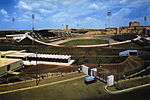Ponte della Magliana
Bridges completed in 1948Bridges in RomeRoad bridges in ItalyRome Q. X OstienseRome S. VII Portuense

Ponte della Magliana is a motorway bridge in Rome (Italy). It crosses the Tiber between Pian due Torri (right bank) and Via del Cappellaccio (left bank), linking the Quartieri Portuense and Ostiense, respectively on the right and on the left of the river. It is currently part of a larger viaduct, which continues on the right bank of the Tiber towards the Colli Portuensi urban zone and the highway to the Fiumicino Airport and on the left one towards the EUR district, the Tre Fontane urban zone and Via Laurentina.
Excerpt from the Wikipedia article Ponte della Magliana (License: CC BY-SA 3.0, Authors, Images).Ponte della Magliana
Ponte della Magliana, Rome Europa
Geographical coordinates (GPS) Address External links Nearby Places Show on map
Geographical coordinates (GPS)
| Latitude | Longitude |
|---|---|
| N 41.839377777778 ° | E 12.457927777778 ° |
Address
Ponte della Magliana
Ponte della Magliana
00144 Rome, Europa
Lazio, Italy
Open on Google Maps









